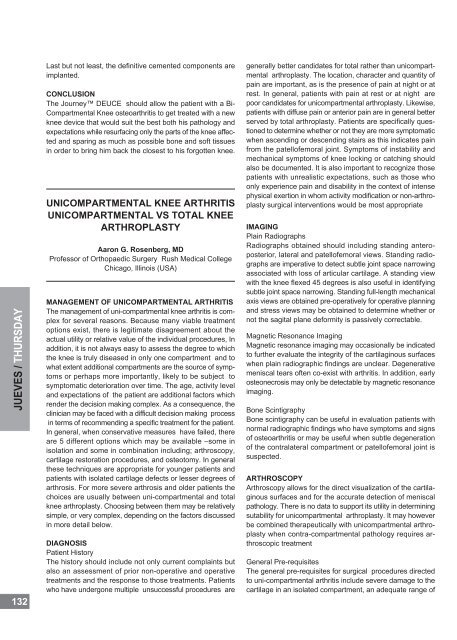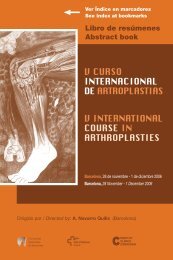Notas / Notes - Active Congress.......
Notas / Notes - Active Congress.......
Notas / Notes - Active Congress.......
You also want an ePaper? Increase the reach of your titles
YUMPU automatically turns print PDFs into web optimized ePapers that Google loves.
JUEVES / THURSDAY<br />
132<br />
Last but not least, the definitive cemented components are<br />
implanted.<br />
CONCLUSION<br />
The Journey DEUCE should allow the patient with a Bi-<br />
Compartmental Knee osteoarthritis to get treated with a new<br />
knee device that would suit the best both his pathology and<br />
expectations while resurfacing only the parts of the knee affected<br />
and sparing as much as possible bone and soft tissues<br />
in order to bring him back the closest to his forgotten knee.<br />
UNICOMPARTMENTAL KNEE ARTHRITIS<br />
UNICOMPARTMENTAL VS TOTAL KNEE<br />
ARTHROPLASTY<br />
Aaron G. Rosenberg, MD<br />
Professor of Orthopaedic Surgery Rush Medical College<br />
Chicago, Illinois (USA)<br />
MANAGEMENT OF UNICOMPARTMENTAL ARTHRITIS<br />
The management of uni-compartmental knee arthritis is complex<br />
for several reasons. Because many viable treatment<br />
options exist, there is legitimate disagreement about the<br />
actual utility or relative value of the individual procedures, In<br />
addition, it is not always easy to assess the degree to which<br />
the knee is truly diseased in only one compartment and to<br />
what extent additional compartments are the source of symptoms<br />
or perhaps more importantly, likely to be subject to<br />
symptomatic deterioration over time. The age, activity level<br />
and expectations of the patient are additional factors which<br />
render the decision making complex. As a consequence, the<br />
clinician may be faced with a difficult decision making process<br />
in terms of recommending a specific treatment for the patient.<br />
In general, when conservative measures have failed, there<br />
are 5 different options which may be available –some in<br />
isolation and some in combination including; arthroscopy,<br />
cartilage restoration procedures, and osteotomy. In general<br />
these techniques are appropriate for younger patients and<br />
patients with isolated cartilage defects or lesser degrees of<br />
arthrosis. For more severe arthrosis and older patients the<br />
choices are usually between uni-compartmental and total<br />
knee arthroplasty. Choosing between them may be relatively<br />
simple, or very complex, depending on the factors discussed<br />
in more detail below.<br />
DIAGNOSIS<br />
Patient History<br />
The history should include not only current complaints but<br />
also an assessment of prior non-operative and operative<br />
treatments and the response to those treatments. Patients<br />
who have undergone multiple unsuccessful procedures are<br />
generally better candidates for total rather than unicompartmental<br />
arthroplasty. The location, character and quantity of<br />
pain are important, as is the presence of pain at night or at<br />
rest. In general, patients with pain at rest or at night are<br />
poor candidates for unicompartmental arthroplasty. Likewise,<br />
patients with diffuse pain or anterior pain are in general better<br />
served by total arthroplasty. Patients are specifically questioned<br />
to determine whether or not they are more symptomatic<br />
when ascending or descending stairs as this indicates pain<br />
from the patellofemoral joint. Symptoms of instability and<br />
mechanical symptoms of knee locking or catching should<br />
also be documented. It is also important to recognize those<br />
patients with unrealistic expectations, such as those who<br />
only experience pain and disability in the context of intense<br />
physical exertion in whom activity modification or non-arthroplasty<br />
surgical interventions would be most appropriate<br />
IMAGING<br />
Plain Radiographs<br />
Radiographs obtained should including standing anteroposterior,<br />
lateral and patellofemoral views. Standing radiographs<br />
are imperative to detect subtle joint space narrowing<br />
associated with loss of articular cartilage. A standing view<br />
with the knee flexed 45 degrees is also useful in identifying<br />
subtle joint space narrowing. Standing full-length mechanical<br />
axis views are obtained pre-operatively for operative planning<br />
and stress views may be obtained to determine whether or<br />
not the sagital plane deformity is passively correctable.<br />
Magnetic Resonance Imaging<br />
Magnetic resonance imaging may occasionally be indicated<br />
to further evaluate the integrity of the cartilaginous surfaces<br />
when plain radiographic findings are unclear. Degenerative<br />
meniscal tears often co-exist with arthritis. In addition, early<br />
osteonecrosis may only be detectable by magnetic resonance<br />
imaging.<br />
Bone Scintigraphy<br />
Bone scintigraphy can be useful in evaluation patients with<br />
normal radiographic findings who have symptoms and signs<br />
of osteoarthritis or may be useful when subtle degeneration<br />
of the contralateral compartment or patellofemoral joint is<br />
suspected.<br />
ARTHROSCOPY<br />
Arthroscopy allows for the direct visualization of the cartilaginous<br />
surfaces and for the accurate detection of meniscal<br />
pathology. There is no data to support its utility in determining<br />
sutability for unicompartmental arthroplasty. It may however<br />
be combined therapeutically with unicompartmental arthroplasty<br />
when contra-compartmental pathology requires arthroscopic<br />
treatment<br />
General Pre-requisites<br />
The general pre-requisites for surgical procedures directed<br />
to uni-compartmental arthritis include severe damage to the<br />
cartilage in an isolated compartment, an adequate range of





